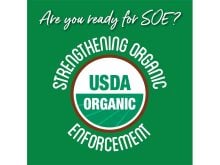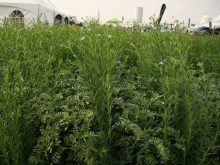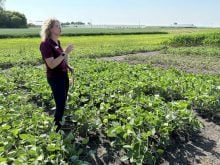Customers of Regina-based Avena Foods see how their ingredients are grown on south Saskatchewan farms
GRIFFIN, Sask. — Organic farmer Shannon Knibbs took a leap of faith this year. She seeded nine quarters to intercrops and tried a pollinator strip.
The five-acre pollinator strip is supported by Once Upon a Farm, an American organic company in which actress Jennifer Garner is involved that produces, among other things, oat bars and other children’s snacks. It sources oats through Regina-based Avena Foods, which organized a recent field tour for its customers.
Knibbs has been growing organic oats for Avena for years and agreed to participate in a pollinator strip project encouraged by the company.
Read Also

House ag committee to undertake several studies
The House of Commons standing agriculture committee has set its agenda for the coming months. Members began the fall sitting with a two-hour update on international trade
“Three years ago we were talking to farmers about trying different practices and they said, ‘you know, there’s a cost to this’ and we said, ‘well you know there are commercial customers who would be interested in supporting growers,’” said Margaret Hughes, Avena’s vice-president of sales and marketing.
There is also a pollinator project at Willmar Farms near Star City, Sask., and another at Melfort. Data from all three will be collected and analyzed once complete.
At Knibbs’ farm, most of the 11 species in the mix from Imperial Seed are growing. The mix was developed at the University of Manitoba.

It contains buckwheat, sainfoin, sunflower, meadow fescue, crimson clover, phacelia, Imperial Select alfalfa blend, chicory, red clover, Persian clover and alsike clover.
“Unfortunately it’s not as good as what I would like it to look like, but it’s a learning curve,” Knibbs told the tour. “I was hoping for more flowers and of course now the wild oats came over top. I was hoping it would be thicker.”
But Michael Ferguson from Willmar Farms told her not to be discouraged because it will improve in the second year.
“Next year your clovers and that will be there and will choke out the wild oats and the weeds,” he said. “On our farm we had one piece seeded last year and we thought the same thing. We had a local cowboy come out and he got 73 bales. This year he got 174.”
Ferguson said it needs time and will flower well into October.
The idea behind pollinator strips is to effectively replace what traditional farmyards and shelterbelts used to do by providing biodiversity that crops need and to act as buffer zones that can protect water bodies and increase soil moisture.
The plants flower at various times to help with pollination and boost yields in the neighbouring crop.
Regan Ferguson told the group how she uses NDVI to measure biomass in the pollinator strip. She also measures biodiversity, water infiltration and soil health.
For Avena customers involved in such projects, the chance to see the pollinator strips up close was important.

Jasmine Byrne, chief operating officer of Big Mountain Foods, said this was the first time she and company founder Kimberly Chamberland were able to attend an Avena tour. Chamberland established the B.C. company in 1987 and has been purchasing from Avena for about 10 years.
“I’m impressed. I’m learning so much,” Byrne said. “We’re trying to learn really where our peas and oats are coming from and what sets Canada apart compared to just purchasing overseas.”
She said she and Chamberland were trying to learn as much as possible about regenerative farming and farming in general.
“There’s a lot of talk right now about regenerative farming,” she said. “We’re not necessarily educated enough in it right now, so we’re just learning and trying to get connected to the farmers.”
Things like pollinator strips show that Canadian farmers are trying to be proactive, she added.
One of the main issues Big Mountain encounters in the United States is concern about glyphosate use. Byrne said a major U.S. natural retailer challenged the company about glyphosate-free certification.
“We’re trying to understand, especially around our peas right now, is glyphosate spraying and if there are negative effects,” she said. “We’re just trying to get ahead of it.”

Knibbs planted an oats/pea intercrop on land that was all oats last year. The oats are a newer variety, ORe 3542. The peas are Meadow.
The seeding rate was two bushels per acre for the oats and about 2.5 bu. per acre for the peas.
Knibbs said her decision to intercrop was made to introduce more competition for weeds. Peas are not good competitors and she said the oats will also help the peas stand up. This fall she will harrow in red clover for a plow down.
Her foray into intercropping will add to her work load as, in addition to running her crops through a Kwik Kleen as she usually does, she has to separate the two.
“I’ve got a lot of work ahead of me in the fall,” she said.


















